1. Introduction

Intel is one of the largest, if not the largest, CPU manufacturer worldwide. Today, Intel supplies the computing and communications industries with chips, boards, systems and software building blocks that are the "ingredients" of computers systems, servers, networking and communications products.
 Intel's new 6xx series of processors, is the answer to the competition, the very popular 64bit processor from AMD. The 6xx series has many similarities with the Prescott and 5xx series, such as 800 MHz FSB and 31-stage pipelines but it has some extra features such as:
Intel's new 6xx series of processors, is the answer to the competition, the very popular 64bit processor from AMD. The 6xx series has many similarities with the Prescott and 5xx series, such as 800 MHz FSB and 31-stage pipelines but it has some extra features such as:
- EM64T : Intel Extended Memory 64 Technology (Intel EM64T) is an enhancement to Intel's IA-32 architecture. The enhancement allows the processor to run newly written 64-bit code and access larger amounts of memory.
- 2MB L2 Cache : A larger cache size can help the processor more efficiently run many popular
applications in digital imaging, music, video and gaming.
- Enhanced SpeedStep : Enables cooler and quieter PC designs (depending on system implementation and
usage).
- Execute Disable Bit : Can improve protection against malicious "buffer overflow" attacks when properly enabled with a supporting operating system.
Processor Features & Definitions |
| Architecture |
Basic design of a microprocessor. May include process technology and/or other architectural enhancements. |
Cache
(MB/KB) |
A temporary storage area for frequently accessed or recently accessed data. Having certain data stored in a cache speeds up the operation of the computer. Cache size is measured in megabytes (MB) or kilobytes (KB). |
Clock Speed
(GHz/MHz) |
Speed of the processor's internal clock, which dictates how fast the processor can process data. Clock speed is usually measured in GHz (gigahertz, or billions of pulses per second). |
Front Side Bus
(GHz/MHz) |
The connecting path between the processor and other key components such as the memory controller hub. FSB speed is measured in GHz or MHz. |
The full Pentium 4 6xx series is given below:
| Model |
Clock Speed |
L2 Cache |
Socket |
FSB |
| Pentium 4 660 |
3.6GHz |
2MB |
LGA-775 |
800MHz |
| Pentium 4 650 |
3.4GHz |
2MB |
LGA-775 |
800MHz |
| Pentium 4 640 |
3.2GHz |
2MB |
LGA-775 |
800MHz |
| Pentium 4 630 |
3.0GHz |
2MB |
LGA-775 |
800MHz |
The sample we received from Intel was for evaluation purposes only and not a production processor. That's why "CONFIDENTIAL" is stamped on the faceplate.

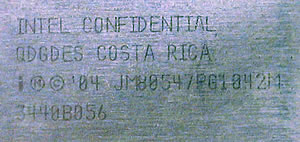
The CPU is a 775 socket, as was the Prescott series. As you can see, there are no pins on the CPU chip itself. Instead, they are located on the motherboard socket.
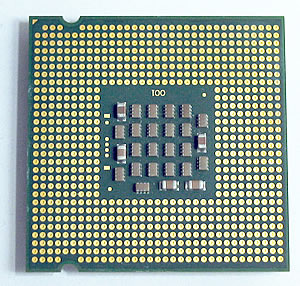
Below you can see the core of the Intel P4 660.

The stock cooler included in the BOX version for the 6xx series, has nine smaller blades instead of the seven larger ones, found on the 5xx series. As the heat increases, so does the rotation speed of the fan making it a little noisy.


2. Test System
Here's a rundown of our testbed used to test the Intel 660 processor:
System Specifications:
CPU: Intel Pentium 4 530 and 660
Cooler: stock
Case: Antec
Motherboard: Asus P5AD2E-Deluxe
Power supply: CoolerMaster 450W
Memory: 2X512 MBOCZ DDR2 PC5300 (dual channel)
VGA: Asus N6800GT PCIe
Hard Disk Drive: WD800JD 80GB 7200RPM
OS: Windows XP Pro SP2
Drivers: 7.1.8.4
DirectX: v9.0c



Benchmarks & Applications used
- Sisoft Sandra 2005
- Prime95
- PcMark04
- 3DMark01
- 3DMark03
- 3DMark05
- PassMark Performance Test V5.0
- Half Life 2 - VST
- Asus Probe 2.23
- FlaskMPEG
- DVD Shrink
- dBPower
- WinRAR
- CPU-Z

3. SiSoft Sandra 2005
SiSoftware Sandra is a 32 and 64-bit Windows system analyzer that includes benchmarking, testing and modules listing. It also provides us with information about the CPU, chipsets, video adapter, i/o ports, printers, sound card, memory, network, Windows internals, AGP, ODBC Connections, USB2, Firewire, etc.
The CPU Arithmetic benchmark, tests how your CPU stacks up to other typical combinations:
Multi-Processor (SMP) support for up to 32/64 CPUs & SMT.
- Test takes about 20/30 seconds on P6-class PCs.
- Test is repeated 3 to 5 times to get a realistic result.
- Results outside the confidence limits (5%) are discarded.
- Command Line Switch: CPUAABench
- Requirements: None
- OS (Win32) Support: Windows 2000, XP, 2003
- OS (Win32 CE) Support: PocketPC 2000/2002/2003, SmartPhone 2002, 2003
- OS (Win64) Support: Windows XP/2003
Sandra's CPU arithmetic benchmark suite uses 2 famous benchmarks (Dhrystone and Whetstone) for stress testing the processor. It also includes a new version of the Whetstone test that makes use of a processor's SSE2 instructions to show the performance boost an application might gain should it be optimized for SSE2. Unfortunately, this does not always represent true real-life performance, but is useful for comparing the speed of various CPUs.

It seems the AMD 64bit processors are slightly better with Dhrystones, the Intel with Whetstone iSSE2 and about even with Whetstone FPU.
The CPU Multi-Media benchmark tests how your CPU stacks up against other typical combinations:
- Multi-Processor (SMP) support for up to 32/64 CPUs & SMT.
- Test takes about 20 seconds on P6-class PCs.
- Test is repeated 3 to 5 times to get a realistic result.
- Results outside the confidence limits (5%) are discarded.
- Command Line Switch: CPUMMBench
- Requirements: MMX (Enhanced), 3DNow! (Enhanced) or SSE(2/3) recommended
- OS (Win32) Support: Windows 2000, XP, 2003
- OS (Win64) Support: Windows XP/2003
The test has two parts:
Integer test - using integer data:
- MP SSE3 is used for better performance if supported.
- MP SSE2 is used for better performance if supported.
- MP SSE (Streaming SIMD) is used for better performance if supported.
- MP Enhanced MMX is used for better performance if supported.
- MP MMX is used for better performance if supported.
- MP ALU is used otherwise.
Floating-point test - using floating point data:
- MP SSE3 is used for better performance if supported.
- MP SSE2 is used for better performance if supported.
- MP SSE (Streaming SIMD) is used for better performance if supported.
- MP 3DNow! Enhanced is used for better performance if supported.
- MP 3DNow! is used for better performance if supported.
- MP FPU is used is used otherwise.
This test involves the generation of Mandelbrot Set fractals that are used to realistically describe and generate natural objects such as mountains or clouds. By using various multi-media extensions (MMX), 3DNow! and SSE(2/3) better performance is achieved.

In this test, Intel seems to win against its rivals from AMD. The 660 performed excellently while even the 32bit, P4 530, showed good performance.
4. PCMark04
PCMark04 is an application-based benchmark and a premium tool for measuring overall PC performance. It uses portions of real applications instead of including very large applications or using specifically created code. This allows PCMark04 to be a smaller installation as well as to report very accurate results. As far as possible, PCMark04 uses public domain applications whose source code can be freely examined by any user.
PCMark04 includes 4 categorized suites for benchmarking your computer. These include CPU, Graphics, Memory and a Hard Disk Drive benchmark. In our case, we selected only the CPU test suite.
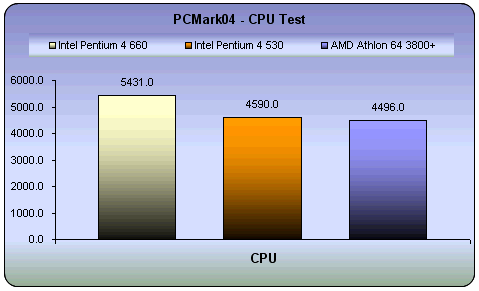
Intel's 660 CPU achieved the highest score among the three CPUs. The P4 530 had slightly better performance than AMD's 3800+.
The results in greater detail:
| |
Intel P4 660 |
Intel P4 530 |
AMD 3800+ |
| File Compression (MB/sec) |
5.3 |
4.1 |
3.3 |
| File Encryption (MB/sec) |
65.6 |
55.8 |
37.2 |
| File Decompression (MB/sec) |
42.9 |
36.5 |
28.9 |
| Image Processing (MPixels/sec) |
16.9 |
14.8 |
14.6 |
| Grammar Check (KB/sec) |
2.4 |
2.2 |
6.5 |
| File Decryption (MB/sec) |
102.3 |
86.4 |
74.2 |
| Audio Conversion (KB/sec) |
2779.1 |
2356.1 |
3171.9 |
| WMV Video Compression (FPS) |
59.7 |
52.1 |
56.2 |
| DivX Video Compression (FPS) |
77.6 |
69.7 |
71.8 |
In almost all the tests, the 64bit processor from Intel seems to lead. The AMD 3800+ was better in the grammar check and audio conversion.
5. 3DMark01
3DMark2001 SE is a diagnostics tool for measuring the 3D game performance of PCs. It is entertaining and easy to use, which makes it "must have" software for all home PC users interested in 3D games. Even a beginner PC user can get a game performance measurement with 3DMark2001 SE.
Although the 3DMark series is more dedicated to 3D graphics performance, it is rather interesting to see how a faster CPU can help the GPU achieve higher FPS.

No doubts about the 3DMark01 score. The settings used were the defaults.
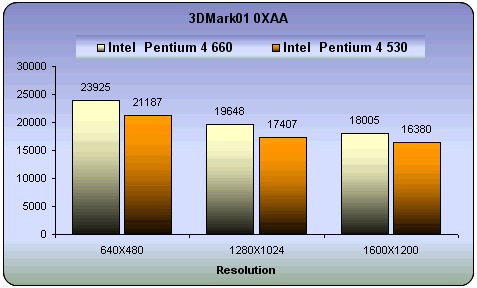

In all resolutions, with either Anti-Aliazing disabled or set to 4X, the Intel Pentium 4 outperformed the P4 530.
6. 3DMark03
3DMark is a widely used and accepted benchmark that stresses the DirectX performance of a VGA card. For testing the performance of each card we use the 4 game benchmark 3DMark offers. The first is a DirectX 7 game, the second and the third use DirectX 8 and the last one stresses graphics in DirectX 9. A very strong point of 3DMark is that its VGA card measuring does not require a lot of CPU power. So the resulting fps are a good reference of a VGA card's rendering performance.

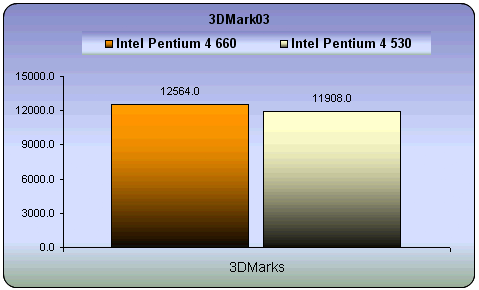

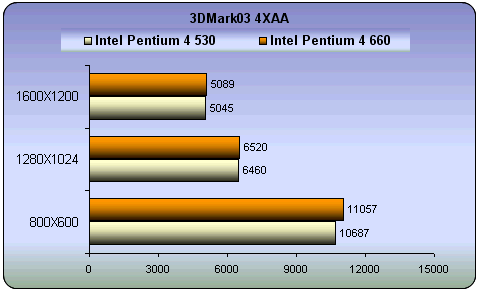
Slightly better performance with the 660 CPU although there's not much between them. As we said above, these benchmarks don't use a lot of CPU power.
7. 3DMark05
3DMark05 concentrates on measuring the performance of the DirectX 9 generation of 3D hardware using the technology of next generation games. Earlier 3DMark versions have usually been launched with the introduction of a new Microsoft DirectX version and with the introduction of a new hardware generation. This has somewhat limited how much 3DMark has utilized the new hardware features. At the time of this writing, DirectX 9 was two years old and there is now DX9 generation hardware available all the way from the very high end to value and mobile parts. 3DMark05 can therefore utilize 100%, the features of DirectX 9. In fact, DirectX 9 hardware is required for every 3DMark05 game test, resulting in the ultimate tool for DirectX 9 hardware performance comparison.

The CPU score for the the P4 660 is much higher than that of the P4 530.



The differences here are not all that great, negligible in fact, which indicates that the specific tests do not really rely on the CPU.
8. PassMark
CPU Benchmarks
The suite of the PassMark Performance Test contains multi-process CPU tests such as:
- Integer (32-bit addition, subtraction, multiplication and division)
- Floating Point (32-bit addition, subtraction, multiplication and division)
- WIN32: MMX (matrix multiplication) or WIN64: 64bit Integer Matrix Multiplication
- WIN32: SSE (128-bit SSE operations such as addition, subtraction and multiplication) or WIN64: 64bit Floating Point Matrix operations
- WIN32: 3Dnow! (3D transformation of an array of 32-bit vertices) or WIN64: 64bit Floating Point Matrix operations
- Compression
- Encryption
- Image Rotation (Rotate image co-ordinates in memory)
- Random String Sorting
Integers are whole numbers such as 23, 459532, -26. Floating point numbers contain a fractional part, eg. 1.003, 98394.2. These two types of numbers are treated quite differently inside a processor, which is why Performance Test differentiates between the two.
For each of the integer tests, a large array of random 32 bit integers is processed using the particular mathematical operations listed below. For the floating point tests, single precision floating point numbers (32 bit) are used.
The "PassMark rating" is a weighted average of all the other test results and gives a single overall indication of the computers performance. The bigger the number, the faster the computer. The "PassMark rating" can only be calculated if the results from all other tests are available. The value is calculated as follows.
| Test Suite |
Weighting |
| Disk |
20% |
| CD / DVD |
9% |
| Memory |
18% |
| 3D Graphics |
12% |
| 2D Graphics |
14% |
| CPU |
27% |
| Total |
100% |
In our case however, we ran only the suite for the CPU.
First, we chose "All" the tests for the CPU, as described above. The following results are those for the Intel 660:
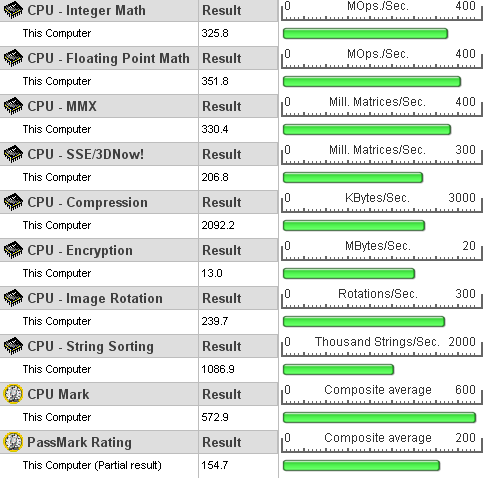
...while the Intel 530 reported the following:
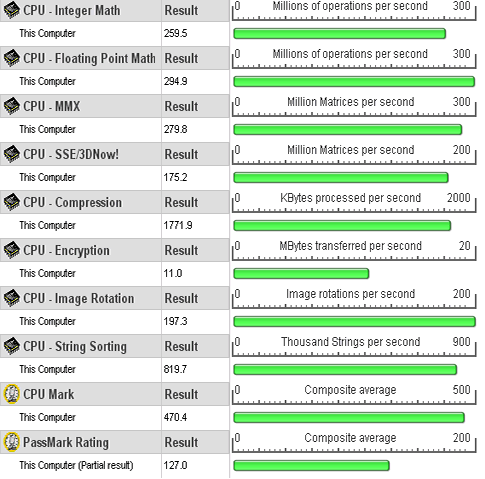
As was to be expected, the P4 660 was much faster than the P4 530. We placed the the performance of the two CPUs together, not so much to see which is better, but only for reference reasons.
Multitasking Benchmarks
The Advanced Multi Process Test of the PassMark benchmark is designed to run a series of standard benchmark tests in parallel to examine the performance under these conditions. Multiple processor machines should excel under this kind of environment, as the load is split between the various CPUs.
The tests include a number of the standard PassMark benchmarks along with some popular benchmarking algorithms and tests which emulate some day-to-day operations your CPU may be required to carry out which are particularly processor intensive.
As the tests are quite varied, as are their results, it unfortunately means that no graphing feature exists as is common amongst the other Advanced Tests. However, it is still possible to export the various results to HTML as usual.
| Test Name |
Intel 660 |
Intel 530 |
Primes found |
| Prime Number Search |
57306 |
45322 |
Primes Found |
| Sorting Random Strings |
84490 |
98977 |
Thousand strings sorted per second |
| Compression |
331 |
212 |
KBytes per second |
| Encryption |
831.61 |
1131.97 |
KBytes per second |
| Rotation |
27.92 |
17.58 |
Rotation per second |
| MMX Addition |
40.87 |
62.82 |
Million Ops/Sec |
| MMX Multiplication |
99.25 |
61.83 |
Million Ops/Sec |
| Integer addition |
44.84 |
56.74 |
Million Ops/Sec |
| Whetstone |
300.50 |
178.27 |
Million Ops/Sec |
| Dhrystone |
159.92 |
207.99 |
Million Ops/Sec |
| Memory Read |
276.58 |
223.32 |
MB/sec |
| Memory Write |
276.59 |
223.50 |
MB/sec |
| Disk Access |
0.73 |
0.15 |
MB/sec |
More details about each test below:
The Tests
- Prime Number Search:
This test uses a simple brute force prime number finding algorithm. It begins at 3 and checks every integer to see if it is a member of the set of primes. (A prime number is one which is divisible only by 1 and itself). The test reports the amount of primes found and the largest prime. Note that for longer test periods, the rate of Primes Per Second found will drop as the distance between primes gets larger.
- Sorting Random Strings:
The test uses qsort to continually sort 1000 strings of 256 characters. Once the test duration expires, the test reports the speed of the sorting in thousands of strings per second.
- Compression:
The Compression test uses an Adaptive encoding algorithm based on source code from Ian H. Witten, Radford M. Neal, and John G. Cleary in an article called “Arithmetic Coding for Data Compression”. The system uses a model which maintains the probability of each symbol being the next encoded. It reports a compression rate of 363% for English text, which is slightly better than the Huffman method. This test reports its results in KBytes/Sec compressed.
- Encryption:
The encryption test uses the Blowfish enciphering algorithm. It is based on the C implementation by Paul Kocher. Data is enciphered using a 16byte key in blocks of 4 KB. The test reports in KBytes/Sec.
- Rotation:
The rotation algorithm is a PassMark developed algorithm using standard rotation mathematics. The test uses a 400 x 400 pseudo image with one byte of data per pixel. The image is rotated degree by degree, with each degree counting as one rotation. The test reports in rotations per second.
- MMX Addition:
- MMX Multiplication:
These are the standard PassMark benchmarks. See MMX Testsfor more information. These tests are only included with the version of PT that is for the 32-bit version of Windows.
- Maths Integer addition:
This is a standard PassMark benchmark. See Maths Tests for more information.
- Whetstone:
The Whetstone benchmark is one commonly used to test floating point arithmetic. The algorithm is based on the original C source code written by Rich Painter. The benchmark is designed to test the speed of commonly used floating point CPU instructions. The test reports in MIPS (Million Instructions Per Second.)
- Dhrystone:
The Dhrystone benchmark is one commonly used to test a machines integer arithmetic. The algorithm is based on the C source code for Dhrystone version 2 by Reinhold P. Weicker. The test reports in MIPS.
- Memory Read:
- Memory Write:
These are the standard PassMark benchmarks. See Memory Tests for more information.
- Disk Access:
This test uses the same test engine as the PassMark Advanced Disk Test. The test uses a file size of the current available RAM, a block size of 4K, the Win32 uncached interface, a 50%/50% RW level, it is 100% Sequential and executed in Synchronous mode. The test reports its results in MB/Sec.
9. Prime95
Prime95 is basically a Mersenne prime number discovery program. It's a great example of Distributed Computing, but it's most loved by overclockers for its powerful system stress-testing and benchmarking abilities. It can torture-test your CPU to produce its maximum heat or spit out any errors due to excessive overclocking. Also, using the blend test, it can consume all your physical memory and run error-checking tests on your modules to ensure their quality. However, right now, we're mostly interested in it for its benchmarking capabilities.
Here are the timings for the Intel Pentium 4 660 and 530, AMD Athlon 64 FX-55 and 3800+. (Less is better)

This test is known for highlighting the weak point in the AMD processors. However, the difference is significant.
10. Encoding
Benchmarks are good for reference and comparison reasons but what about real performance? For this reason, we carried out some simple tests using popular utilities that most users perform every day.
dBPower Tests
In the following graph, you can see how three different CPUs performed while encoding the same audio file into different formats. For this we used a whole music CD with a size of 750MB. We ripped the AudioCD using EAC and then with dBPower, we encoded from one format to another. The times needed for each task are given below. ( The lower the better off course :-)
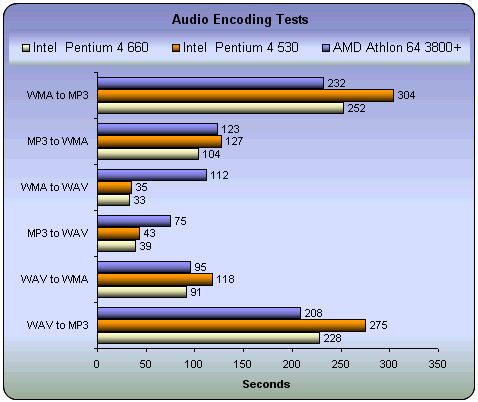
Depending on the file type, the Intel P4 660 was faster in some cases while the AMD in others. MP3 seems to be handed better mostly by the AMD processor while WMA by the Intel 660.
The settings for dBPower were the same for all CPUs. Analytically:


DVD Shrink Tests
Compressing a movie from DVD9 to DVD5 is a very common task. For this reason we ripped an original movie, which we own off course :-), using DVD Decrypter. Then, with DVD Shrink, we compressed it in order to fit on a DVD5 disc. The size of the original movie was 6.85GB and we made it 4.463GB. Below you can see how many frames per second each CPU can process and the total time needed for the encoding.


It's amazing how many fps the 660 can handle. The encoding time is also very low. The whole project with the 660 took us not more than eight minutes!
DivX Tests
Another very common task is to convert a movie to the DivX format. For this we used a .vob file sized 202MB which, with FlaskMPEG, converts it to .avi. The settings are given below:


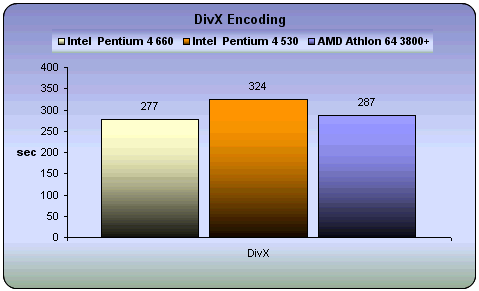
Encoding with the 660 is much faster than with the 530, if we consider that the tested .vob file was only 202MB. However, compared to the time the AMD needed, it was not that much faster.
WinRAR Tests
Using a folder with a variety of data of 101MB capacity, we checked how many times each of the tested CPUs needed to compress and extract it.

The AMD proved to be the fastest in the compression task, while it needed more time to extract the files than the Intel CPUs.
11. Half Life 2 - VST
Half life 2 is no doubt the most anticipated pc game of all times. Gamers having the excellence of Half Life 1 in mind, as well as the remarkable E3 demo preview, have been anxiously waiting for the much delayed release of HL2.
Physics - From pebbles to water to 2-ton trucks respond as expected, as they obey the laws of mass, friction, gravity, and buoyancy.

Graphics - Source's shader-based renderer, like the one used at Pixar to create movies such as Toy Story® and Monster's, Inc.®, creates the most beautiful and realistic environments ever seen in a video game.
AI - Neither friends nor enemies charge blindly into the fray. They can assess threats, navigate tricky terrain, and fashion weapons from whatever is at hand.
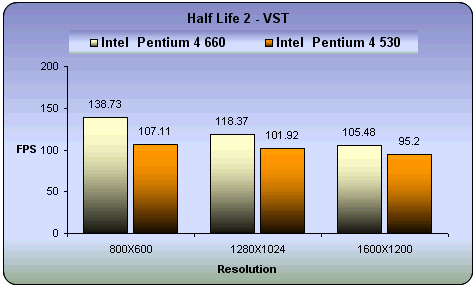
As we stated previous tests, the performance of the P4 530 CPU is given here, more for reference reasons.
12. Overclocking
We used the overclocking settings of our Asus motherboard and we set overclocking to 1000FSB/667RAM for the Intel Pentium 4 3.00Ghz 530. The CPU launched at 3.75Ghz.


In the case of the Intel 660, we discovered a bug on our motherboard. If we set overclocking to automatic settings, even if we set it to 30%, the CPU couldn't manage to go over 3.65Ghz. This is because the multiplier was decreased automatically from 18 to 14, although we had disabled the appropriate feature for this ( CPU Lock Free) and set the maximum for the multiplier. In this case, we manually changed the FSB. As it can been seen below, the 3.6Ghz CPU reached almost 4.00Ghz. We believe that the CPU could perform even higher than this.
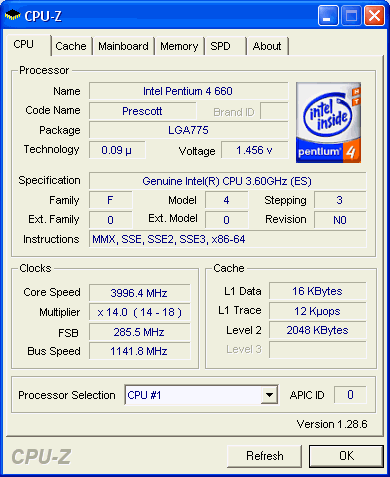
The CPU temperature at idle was approximately 40 °C. When we overclocked the CPU to 4.00Ghz, this changed to 44 °C.
We also ran an Arithmetic Benchmark from SiSoft Sandra 2005 which produced these results:

We have seen higher core speeds for both of the two CPU's, for example the P4 530 from 3.00Ghz to 3.9Ghz but with a different system, motherboard, RAM, chipsets, etc. Unfortunately, during our tests, we couldn't overclock any higher and it wouldn't be fair to report performances for these two CPUs on different systems.
13. Conclusion
The Pentium 4 660 is at the top of Intel's 64-bit family line if we don't consider the existence of the newer Extreme Edition series at 3.73Ghz. After all the tests we did, we can say that the Intel CPU is recommended mostly for Video compression or DivX conversion and audio encoding, especially to the WMA format. The performance of the 660 during all the benchmarks we ran was very good in all tasks. However, MP3 encoding or compressing files with WinRAR is still best with the AMD. Game performance with the Intel 660 is also very good although it still lags behind compared to the AMD processors.

This CPU is more suitable for a high-end system. In our opinion, the choice of the 640 seems more logical. The value of the 6xx series, as it was expected, is higher than the 5xx series, $615 for the 660 and $410 for the 560 for example at Newegg, both at 3.6Ghz. It also falls between the cost of the AMD 4000+ and the FX-55. However, $615 is a lot and for this reason we should not forget the new dual core series that was recently released on the market. So, before upgrading your system with a 6xx processor, it may be prudent to wait for a while.